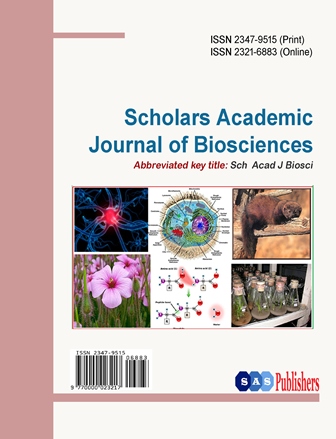+91-9365665504
+91-8724002629
submit@saspublishers.com / saspjournals@gmail.com

An International Publisher for Academic and Scientific Journals
Author Login
Scholars Academic Journal of Biosciences
Journal Home
Description
Editorial Board
Archives
Indexing
Statistics
Title : Scholars Academic Journal of Biosciences
Abbr : Sch Acad J Biosci
ISSN (Online) : 2321-6883
ISSN (Print) : 2347-9515
Discipline : Biological Science
Frequency : Monthly
Country : India
Language : English
Abbr : Sch Acad J Biosci
ISSN (Online) : 2321-6883
ISSN (Print) : 2347-9515
Discipline : Biological Science
Frequency : Monthly
Country : India
Language : English
10.36347/sajb
DOI
DOI
9.8 (ICV = 79.17)
IMPACT FACTOR
IMPACT FACTOR
Current Issue : Volume-14 - Issue-01 ; 2026
Recently Published Articles
Jan. 8, 2026 | Review Article
The Role of miR-132 in Pathogenesis and Therapeutic Targeting of Cardiovascular Disease
Muhammad Arsalan Ayub, Muhammed Rahim, Waleejah Qandeel, Sulman, Peter John, Rabiya Zafar, Mohsin Ali, Muhammad Nadir
Sch Acad J Biosci | 60-73
DOI : https://doi.org/10.36347/sajb.2026.v14i01.003
Jan. 8, 2026 | Original Research Article
Uptake of Sodium and Lithium in Oryza sativa L. Cv. Super Kainat Exposed to Different Concentrations of NaCl and LiCl
Misbah Kalsoom, Shoaib Hassan Raza, Nida Anwar, Rabiya Bashir, Sajjad Hasan, Ammara Ahsan
Sch Acad J Biosci | 9-59
DOI : https://doi.org/10.36347/sajb.2026.v14i01.002
Jan. 8, 2026 | Review Article
Trends in Allergic Diseases and Parental Knowledge on Food Labeling: Eczema, Food Allergy, and Rhinitis
Ihab Mousa Ibrahim Rawaqa, Yazan Abdel Majed Soluman Alrawashdeh
Sch Acad J Biosci | 1-8
DOI : https://doi.org/10.36347/sajb.2026.v14i01.001





